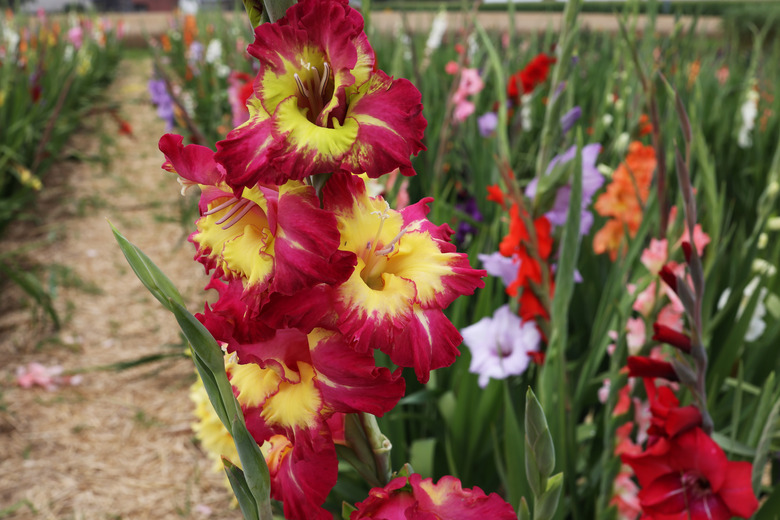Do You Have To Dig Up Gladiolus In Fall?
We may receive a commission on purchases made from links.
There is a lot of chatter among gardeners regarding the winter hardiness of gladiolus, called simply "glads" by fans. The traditional wisdom is that you must dig up the corms of glads (Gladiolus spp.) in the fall and store them over the winter if you live in a zone colder than USDA plant hardiness zone 8.
Tip
Gladiolus should be dug up and stored over the winter to protect the corms, which are not generally cold hardy enough to withstand a hard freeze, considered 28 degrees Fahrenheit or colder. Some gardeners have experience with glads that have come back after hard freezes, however.
To Dig or Not to Dig
To Dig or Not to Dig
Glads are officially assigned to USDA hardiness zones 7 to 10, in which their corms can be left in the ground year-round. Some experts suggest digging them up and storing them over the winter in these zones anyway as a best practice for ensuring the future health of the corms over time and to produce the best blooms. This also can help prevent disease from carrying over from year to year as well as overcrowding in a bed.
Many sources, however, recommend digging up the corms only in regions 7 and colder, but some gardeners report that their glads have overwintered successfully in regions as cold as zone 5 or even 3. Usually, they discover this by accident, having failed to dig up their corms in the fall. Over time, even if the flowers return and bloom, natural attrition will occur in which fewer and fewer corms will remain viable and sprout. Nonetheless, it may be possible to protect them and coddle them in the ground over the winter.
If you wish to try keeping your glad corms in the ground, follow a few best-practice growing strategies. First, be sure your gladioli are situated in a full-sun location in sandy or at least well-drained soil. Plant them extra deep — 6 inches instead of the normally recommended 2 to 4 inches. Finally, cover them with a thick layer of mulch, such as straw, grass clippings, or fallen leaves. If it snows in your area, that's fine too; the snow will provide additional protection from freezing wind.
Some nurseries specialize in hybridizing smaller, more cold-hardy gladiolus varieties, advertised to be hardy down to zone 5.
How to Store Glads Over the Winter
How to Store Glads Over the Winter
After your gladiolus has bloomed, don't down off the stalk. The key point to know before digging up your glads is to wait until the foliage has completely died — not just wilted, but dried. Until then, the foliage is still feeding the bulb nutrients. This is usually about six weeks after bloom in midfall. Using a spade, dig up the entire plant, taking care not to bruise the corm. At this point, you can cut off the withered stalk about 1 to 2 inches above the corm.
Dry the corms in a shady, warm location for about two weeks until completely dry. At this time, you can remove the small "cormels" that may be growing on the mother corm, saving these and replanting them if you wish. It will take two or three years before these bloom, but they will be identical to the mother plant, so it may be worth it.
At this point, you can remove and discard the oldest corm, which will still be connected to the bottom of the new corm. Retain the husks and then dust the corms with a fungicide by placing the corms in a paper bag with the fungicide and shaking. Store the corms in a dry location where they won't touch each other, such as in newspaper or sawdust. If you have a basement, that's perfect, as you want a temperature of about 35 to 45 degrees. Don't let the corms freeze.
In the spring, replant the corms a couple of weeks after your location's last frost. They should bloom by midsummer.
